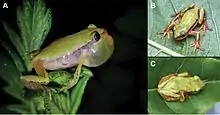Afrixalus clarkei
Afrixalus clarkei is a species of frog in the family Hyperoliidae.[1][3][4] It is endemic to southwestern Ethiopia and has been recorded from near Chira, Jimma, Bonga, and Bodare.[3][5] The specific name clarkei honours Mr and Mrs R. O. S. Clarke (hence emendation to plural clarkeorum,[6] but such change is nevertheless considered unjustified under the International Code of Zoological Nomenclature[7]), who are acknowledged for their help and hospitality.[2][6] Common name Clarke's banana frog has been coined for this species.[1][3][8]
| Afrixalus clarkei | |
|---|---|
 | |
| Scientific classification | |
| Kingdom: | Animalia |
| Phylum: | Chordata |
| Class: | Amphibia |
| Order: | Anura |
| Family: | Hyperoliidae |
| Genus: | Afrixalus |
| Species: | A. clarkei |
| Binomial name | |
| Afrixalus clarkei Largen, 1974[2] | |
| Synonyms[3] | |
|
Afrixalus clarkeorum Largen, 1974 (unjustified emendation) | |
Description
Adult males measure 20–23 mm (0.8–0.9 in)[2][4] and adult females 23–24 mm (0.9–0.9 in) in snout–vent length.[2][5] The head is broad with short snout. The tympanum ranges from completely hidden to somewhat noticeable. The fingers are unwebbed or have some webbing between the fingers III and IV. The toes are moderately webbed. Dorsal skin is smooth, but chest and abdomen may be rather coarsely granular. The dorsum is yellow-green to bright green, sometimes rarely olive to dark brown, with some scattered small white flecks and larger dark brown spots. There is a pair of dorsolateral lines or rows of dark brown spots, and broad brown lateral stripe running from the tip of the snout over the eye and reaching almost the groin. Males have yellow gular flap.[2]
The male advertisement call consists of an initial creak, followed by a small number of metallic clicks.[2][4]
Habitat and conservation
Afrixalus clarkei is found in tropical deciduous forests and forest edges as well as in some moderately modified secondary habitats such as coffee plantations[1] at elevations of 820–2,030 m (2,690–6,660 ft) above sea level.[5] It has recently been recorded also in marshes and riverine floodplains in open disturbed landscapes.[5] Afrixalus clarkei breeds in marshy pools with emergent vegetation. It is threatened by habitat loss caused by selective logging and encroachment of agriculture and human settlements. It is present in the Kafa Biosphere Reserve.[1]
References
- IUCN SSC Amphibian Specialist Group (2013). "Afrixalus clarkei". IUCN Red List of Threatened Species. 2013: e.T56057A16950443. doi:10.2305/IUCN.UK.2013-1.RLTS.T56057A16950443.en.
- Largen, Malcolm J. (1974). "The status of the genus Afrixalus (Amphibia, Anura, Hyperoliidae) in Ethiopia, including descriptions of two new species". Monitore Zoologico Italiano. Nuova Serie, Supplemento. 5: 111–127. doi:10.1080/03749444.1974.10736796.
- Frost, Darrel R. (2018). "Afrixalus clarkei Largen, 1974". Amphibian Species of the World: an Online Reference. Version 6.0. American Museum of Natural History. Retrieved 24 September 2018.
- "Afrixalus clarkei". AmphibiaWeb. University of California, Berkeley. 2008. Retrieved 24 September 2018.
- Mertens, Jan; Jocque, Merlijn; Geeraert, Lore & De Beenhouwer, Matthias (2016). "Newly discovered populations of the Ethiopian endemic and endangered Afrixalus clarkei Largen, implications for conservation". ZooKeys (565): 141–146. doi:10.3897/zookeys.565.7114. PMC 4820099. PMID 27081339.
- Beolens, Bo; Watkins, Michael & Grayson, Michael (2013). The Eponym Dictionary of Amphibians. Pelagic Publishing. p. 43. ISBN 978-1-907807-42-8.
- Dubois, Alain (2007). "Genitives of species and subspecies nomina derived from personal names should not be emended". Zootaxa. 1550 (1): 49–68. doi:10.11646/zootaxa.1550.1.2.
- Afrixalus clarkei media from ARKive
